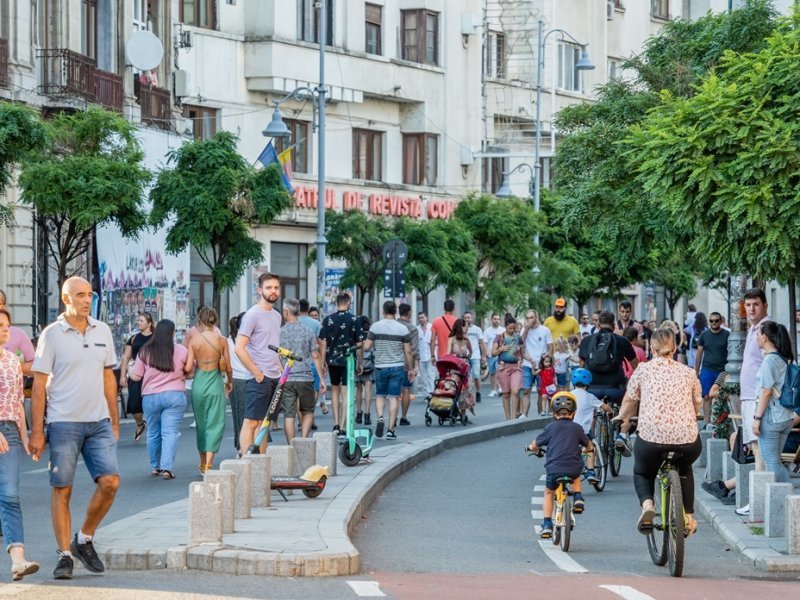How “walkable” is Bucharest: neighborhoods where you can live without a car

By Bucharest Team
- Articles
We live in a city where traffic has become part of everyday conversation. In Bucharest, the time spent in a car often rivals the time spent at work.
And yet, more and more people are choosing a different perspective: a Bucharest experienced on foot, where distances are measured in minutes, not kilometers.
But how “walkable” is the capital, really? And in which neighborhoods can you truly live without a car?
What makes a city “walkable”
A “walkable” neighborhood means:
- Safe, continuous, and wide sidewalks
- Shops, cafés, pharmacies, schools, and public transport within 10–15 minutes on foot
- Green spaces and pedestrian areas you can reach without crossing dangerous boulevards
In short, it’s a place where a car is a convenience, not a necessity.
1. The City Center – Calea Victoriei, Romană, Universitate
The central area of Bucharest remains the most accessible for a car-free lifestyle.
Within a 15-minute radius, you can reach everything you need: public transport (metro, buses, trolleys), restaurants, pharmacies, theatres, parks, and supermarkets.
Calea Victoriei is already a model of a “street that breathes.” The pedestrian weekends have completely changed how locals relate to public space. Here, you can walk for kilometers without crossing busy roads — an urban luxury in itself.
The downsides? Noise, lack of parking (for those who still have cars), and high rents.
2. Dorobanți – elegant and compact in the central-north
Dorobanți is a well-balanced neighborhood where modern comfort meets pedestrian convenience.
Its narrow, tree-lined streets make it a pleasure to walk through, and within minutes you can find everything you need: cafés, shops, schools, pharmacies, restaurants.
The area benefits from a compact urban structure inherited from the interwar period. You can literally live here without a car:
- Dorobanți Square, Piața Victoriei, and Aviatorilor are all within walking distance
- Metro stations (Victoriei, Ștefan cel Mare, Aviatorilor) are 10–12 minutes away on foot
- The sidewalks are mostly shaded and clean, which makes walking genuinely enjoyable
The main disadvantage is, of course, the price. Dorobanți is one of the most expensive neighborhoods in Bucharest, but also one of the few where “neighborhood life” still means walking everywhere.
3. Floreasca – between the park and the city
Floreasca is the kind of neighborhood that convinces you Bucharest can still be livable. It has its own rhythm — calmer, greener, yet still urban.
With Floreasca Park and Verdi Park just steps away, plus cafés, restaurants, shops, and public transport close by, it’s become a favorite for young families and remote workers.
Within a 10–15 minute walk, you can reach:
- three large parks
- clinics, pharmacies, and gyms
- metro stations (Aurel Vlaicu, Ștefan cel Mare)
- supermarkets and local markets
Floreasca has long outgrown its purely residential image — it’s now a blend of community, lifestyle, and accessibility. The only real downside is the heavy traffic on surrounding boulevards (Barbu Văcărescu, Floreasca, Calea Dorobanți).
4. Cotroceni – quiet, traditional, and close to everything
Cotroceni is one of the most pleasant neighborhoods to explore on foot.
Its old houses, lush gardens, and quiet side streets create the feel of a small European town. Everything is nearby: parks (Romniceanu, Eroilor), good schools, clinics, corner shops, and public transport.
Although it doesn’t have a central square, Cotroceni maintains a strong sense of community and safety, making daily walks genuinely enjoyable.
The only challenges are the surrounding transit traffic (Eroilor, Panduri) and the limited metro coverage across all parts of the district.
5. Tineretului – accessible and balanced
If you want to live without a car but in a more affordable area, Tineretului is a great choice.
It has the advantage of a huge central park, numerous shops, kindergartens, schools, and excellent metro access (two stations within a 10-minute walk).
Everything is easy to do on foot, and the atmosphere feels friendly and lived-in — a real neighborhood, not a tourist zone.
Conclusion
Bucharest is not yet a fully “walkable” city. Sidewalks are uneven, intersections are busy, and cars parked on pavements still block pedestrians.
But there are pockets of functional urbanism where a car-free life isn’t just possible — it’s actually pleasant: Calea Victoriei, Dorobanți, Floreasca, Cotroceni, and Tineretului.
Living on foot in Bucharest means less noise, less stress, and a reconnection with the city — with its real rhythm, the one that starts only after you step outside the car.
Sources:
- ResearchGate – Walkability Assessment of Central Area of Bucharest (2019)
- Google Maps / OpenStreetMap data – analysis of distances and pedestrian infrastructure






























